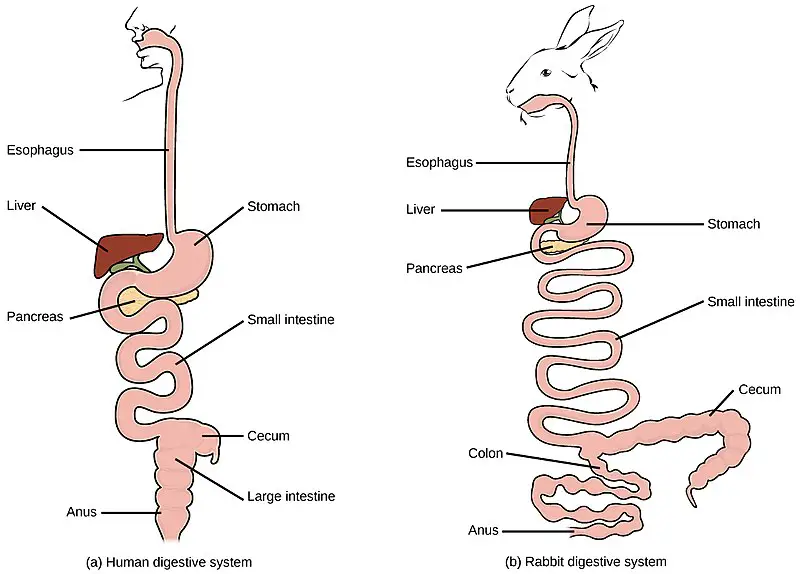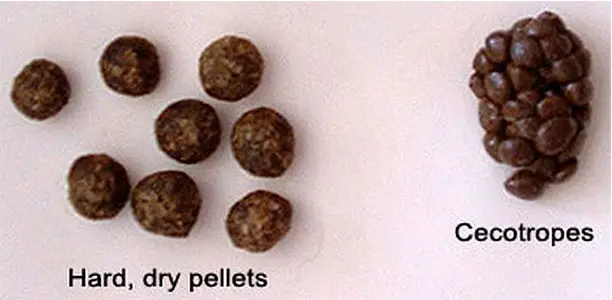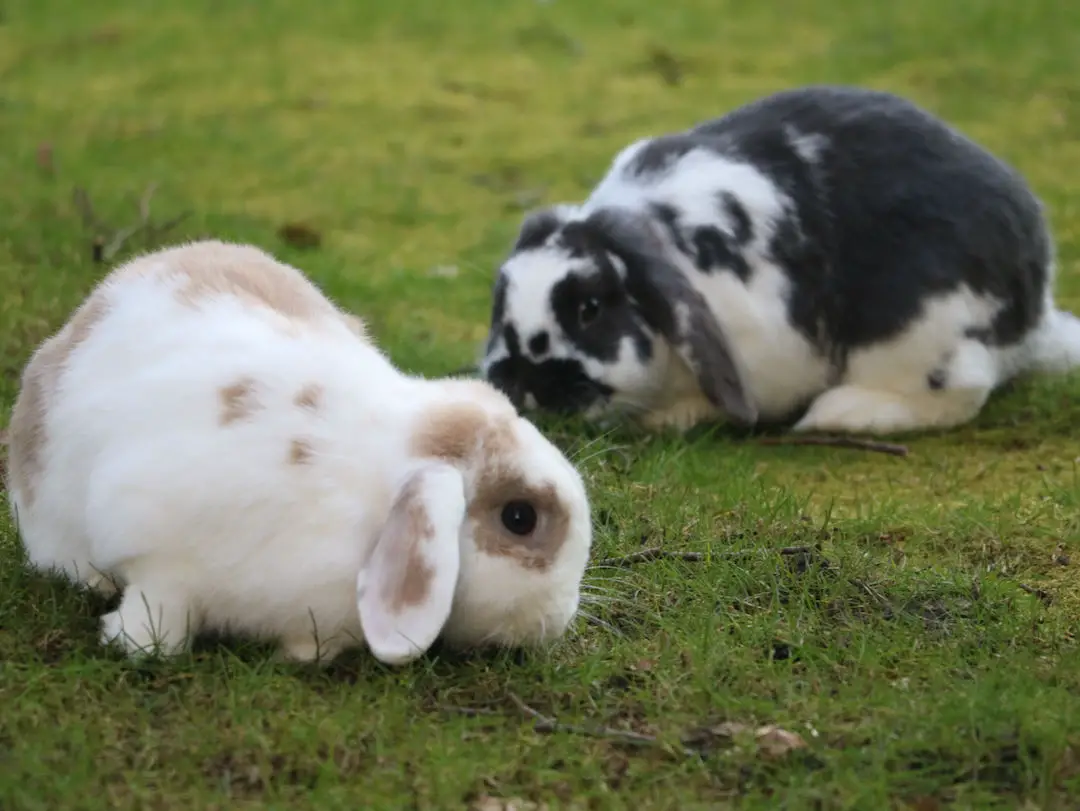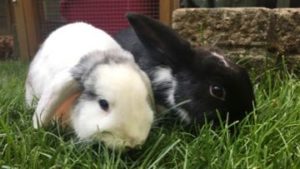By Lucy
Introduction
Have you ever wondered how your rabbit digests its food? This article explains everything, from enzymes to coprophagy.
Interestingly, a rabbit’s digestive system shares many similarities with that of a horse. Both animals use a process called hind-gut fermentation which is where microbial digestion takes place towards the end of the digestive path, in the caecum (or cecum).
However, a rabbit has a relatively small digestive tract compared to many other animals and so it has a complex system in order to use their nutrition as efficiently as possible. For example, to accommodate large amounts of food through their short tract, it travels through at a faster rate than other animals.
Rabbits have a uniquely designed gastrointestinal system due to their diet consisting of large volumes of fibrous plants. These plants are indigestible to most mammalians, such as humans (which is why we don’t eat hay), but a rabbit is unique.
What is the role of the digestive system?
Just like in all animals, the primary purpose of the rabbit digestive system is to digest the food consumed and make use of all the nutrients through absorption.
When food is initially ingested, the nutrients that the body requires can’t be directly used, because the molecules are too large to be absorbed through the walls of the intestine and stomach. So, digestive enzymes break these down (through hydrolysis reactions) into what are essentially their ‘building blocks’. These smaller molecules can then be absorbed through the lining of the digestive tract and used throughout the body.
The digestive tract also protects the body from disease and is a vital part of the immune system, just like in humans. The acidic stomach environment destroys bacteria and other pathogens, preventing infection. The final part of the digestive system is also crucial; waste is removed by defecation.
How fast does food pass through the rabbit digestive system?
Perhaps surprisingly, there is no one answer as to how fast food can pass through the digestive system of a bunny. Different types of food pass through the rabbit’s digestive system at different rates. Times can vary between 5 and 20 hours. The larger, and more indigestible, the food, the faster it goes through the rabbit. The smaller and more digestible, the longer it spends being digested.
So if you feed your rabbit some fibrous, long stemmed hay, it can pass through a bunny in about five hours (some scientists have actually tracked this, spending their time monitoring rabbit poo for our benefit. See this article – Sakaguchi et al (1992) for more information). Smaller, finer particles took longer to pass through – up to 10 hours. Other studies found different times (10 hours for larger particles; up to 20 hours for fine particles).
Why are there different times for different sized particles? It is to do with the unique way bunnies digest their food, particularly their caecum – more about this below.
The journey from mouth to anus
As you can see in this diagram below, the alimentary canal of a rabbit looks fairly similar to a human one, however you’ll soon find out how much they differ.

What happens in the mouth of the rabbit?
The rabbit bites the food using its front teeth, also known as incisors, before being ground by the molars into tiny pieces and mixed with the enzyme-containing saliva.
The most prominent enzymes involved here are amylase and galactosidase and are secreted by the mandibular salivary glands.
Like bunnies, we also have amylase in our mouths – it begins to break starch down into sugars. Have you ever kept a piece of bread in your mouth, and noticed it starts to taste sweet? That’s amylase at work.
What happens in the rabbit’s oesophagus?
The oesophagus (or windpipe) is the long tube that connects the mouth to the rest of the digestive system. No digestion takes place in the windpipe. The swallowed food travels down into the stomach.
What happens in the rabbit’s stomach?
Rabbits actually have quite large stomachs because they are crepuscular. This means that they primarily eat at dawn and dusk and so eat large meals (see more about rabbit sleeping patterns in our article here).
Their stomachs are also rarely empty. Even after not eating for several hours they will still be mostly full with a mass of food material and hair in fluid. The digestive enzymes in the stomach, such as pepsin, break down the large molecules as the food is churned by the stomach muscles and turned into chyme (the mixture of stomach secretions and partially digested food).
What happens in the rabbit’s small intestine?
More enzymes further hydrolyse the food molecules, allowing them to pass through the small intestine’s lining into the bloodstream and finally be used throughout the body. Peristaltic contractions push the food material through the intestine, aided by a peptide called motilin which smooths the contractions. However, this is where the uniqueness of the rabbit’s digestive system begins.
What happens in the rabbit’s large intestine and caecum?
Whatever is still left after leaving the small intestine travels towards the colon (large intestine). This will be the undigested food containing lots of fibre which can’t be broken down by the digestive enzymes.
This material is then cleverly divided into digestible and indigestible. The indigestible material enters the colon where water is absorbed and then eventually exits as faeces. This is the small droppings we clean out of our rabbit’s litter tray. This indigestible material is still a vital part of any rabbit’s diet as it stimulates movement in the digestive tract and allows the chyme to easily travel through it. To read more about hay in a rabbit’s diet, check this article on Timothy hay.
The digestible material containing soluble fibre enters the caecum, a large blind sac at the junction of the small and large intestine. This sac actually expands to be 10x the volume of the stomach. Here, microbial bacteria break down many of these molecules through fermentation and digestion into nutrients which can be absorbed and used for essential bodily functions.
The remaining material is formed into small pellets known as caecotropes (also known as cecotropes). These are also known as soft faeces and are characterised by their distinct smell and are coated in a mucus layer. As these pass out of the rabbit, their brain receives a signal so they consume these grape-like droppings whole as they are expelled, and therefore aren’t considered waste material.
You may never see these as rabbits tend to do this at night or very early in the morning. In fact, if you see these, especially in large quantities, you should speak to a vet since there may be a serious reason your rabbit isn’t doing this important process as expected.
The purpose of this process (coprophagy – a word derived from Greek which means poo-eating) is to allow the rabbit to digest the material again and get the most nutrients possible as the small intestine can now more easily absorb them.
Here is a picture illustrating the difference in appearance between the hard faeces you see all the time and the caecotropes which will be a rare sight.

How do I know if my rabbit has a digestive problem?
Fibre is extremely important for healthy digestion and for wearing down those herbivore teeth. A low-fibre diet can therefore lead to digestive and dental problems.
It’s important to keep a close eye out for any signs that might suggest their digestive system isn’t working the way it should be. As mentioned previously, if your rabbit isn’t consuming their caecotropes, this is also an indicator of a problem. As you would expect, any unusual faeces such as loose faeces or diarrhoea are also a reason to visit the vet.
If your rabbit goes off their food and you notice that they aren’t eating as much, if any, then this is definitely a cause for concern. If small herbivores stop eating, they can become very ill rapidly as their digestive systems are so delicate so don’t hesitate to seek professional advice as soon as possible. Lethargy is also a reason to see medical help as they may be in pain or not receiving adequate nutrition.
What digestive problems do rabbits get?
The most common issue is GI (gastrointestinal) stasis which is a potentially deadly condition in which the digestive system slows down or stops completely.
It isn’t just constipation. When the digestive system is slowed, bacteria begin to build up and release gases that cause painful bloating. The rabbit is then further unmotivated to eat or drink which leads to dehydration and lack of vital nutrition. Then it will be even more difficult for any food material to pass and also toxins from the bacteria will lead to organ failure.
What causes GI stasis?
The digestive systems usually slows down because:
- The rabbit is receiving a high starch, low fibre diet
- The rabbit is stressed – may be because:
- Friend passed away
- Environment changed
- Other stressful event
- Pain from another issue such as:
- Dental problems
- Gas
- Urinary infections
- Lack of exercise
How is GI stasis treated?
Rabbits can definitely make a full recovery but it is important to recognise symptoms early. Usually, the aim is to improve motility (movement) in the gut and so the vet may provide your rabbit with some of the following:
- Motility drugs eg cisapride
- IV fluids to help soften the mass in the intestines
- Pain medication
- Syringe feeding to ensure the rabbit receives essential nutrients
- Antibiotics to destroy harmful bacteria
- Continue to offer hay, should they find motivation to eat
Summary
Rabbits have a unique and elaborate digestive system that although shares some similarities with other mammals’, isn’t identical to any of them. The distinctive process of separating digestible and indigestible material is crucial for a rabbit’s survival and is the centre of their complex system. Every aspect of a rabbit’s digestive system works together to maintain efficient nutrition. The best way in which you can aid your rabbit’s digestion is to provide them with an appropriate diet, consisting of grass, hay and fibrous plants.
If you’re interested in how rabbits digest their food, check out these other articles:
- We have a complete guide to vitamins and minerals for rabbits here.
- And here, you can find out which fruit your bunny can eat, how much to feed them, and which fruit to avoid.
- We also cover which herbs are safe for rabbits here.
- If you’re concerned about your rabbit’s health, it’s good if you know that you don’t have to worry about vet fees. Check out how much rabbit insurance costs here, and why it’s a good idea.


